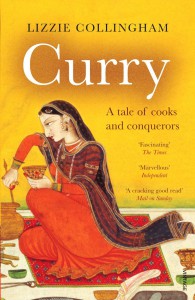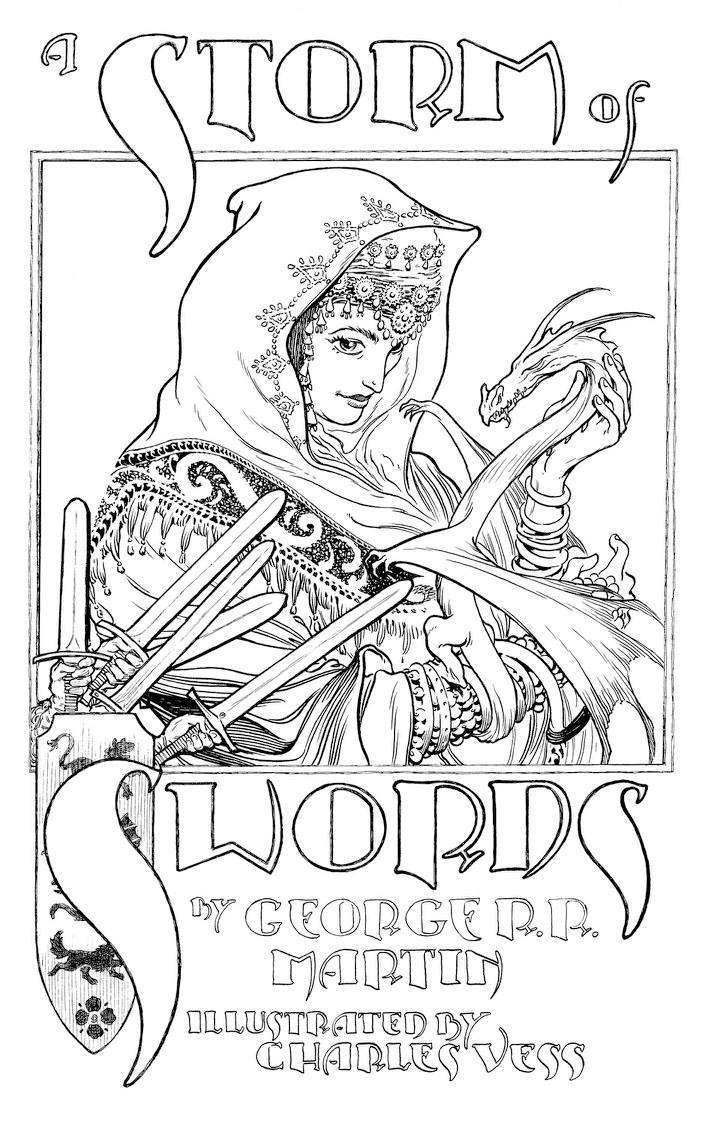
Lizzie Collingham – Curry: A Tale of Cooks and Conquerors
Reading Curry: A Tale of Cooks and Conquerors by Lizzie Collingham, and learning fascinating things about different kinds of Indian cuisine.
Among the myths busted and tales told, the most wondrous are the account of the food habits of early Hindus, easily .
One of the best records of Hindu courtly cuisine has been left to us by the twelfth-century King Somesvara III. He belonged to the Western Chalukyan dynasty of kings who ruled over parts of present-day Maharashtra and Karnataka. Unusually for a king, he was more interested in the arts and literature than in waging war. Although parts of the kingdom were slipping out of Chalukyan hands, he busied himself with writing an encyclopedic account on the conduct of kingly affairs. Delightfully entitled Manasollasa, meaning refresher of the mind, it paid some attention to the conduct of affairs of state and the qualities needed by a king.
A king needed to eat a “suitable, healthy and hygienic” diet. This might include lentil dumplings in a spicy yogurt sauce, fatty pork fried with cardamoms, or roast rump steak.Alongside mutton, pork, and venison, “sparrows and rats, and cats and lizards” could all be found on sale in the markets of the capital city. Some of Somesvara’s other favorite dishes sound less appetizing: fried tortoise (said to taste like plantain) and roasted black rat.
Oh, fuck yeah, Chalukyas. A far cry from 2015, when I spent a few hours poking around shops in Sikkim and on the Nepal border looking for dried buffalo meat – sukuti, as it is called locally. Apparently they no longer sell it in Indian towns any more, despite the healthy presence of a Nepali population. My heart still withers at the memory of a 4 kilo pack of sukuti that the cleaning lady in my Hyderabad apartment threw in the trash on her own initiative because it smelt funny. I would have dump-dived to get it back but she also made sure to throw the trash out well before I came back home.
The book goes on to talk about Somesvara’s rat recipe.
The rats which are strong black, born in the fields and river banks are called maiga; these are fried in hot oil holding with the tail till the hair is removed; after washing with hot water, the stomach is cut and the inner parts are cooked with amla [sour mango] and salt; or the rat is kept on iron rods and fired on red hot coal, till outer skin is burnt or shrinks. When the rat is cooked well, salt, cumin and sothi [a flour made from lentils] are sprinkled and relished.
The Mughlai section of the book begins with Babur’s dismay at this strange land, so different from that of his forefathers.
The people paraded about naked apart from grubby loincloths and lacked beauty; society was devoid of grace or nobility, manners or etiquette. No one possessed any poetic talent, a sign of the highest cultivation in his homeland. One of Babur’s chief complaints against Hindustan was that the food was awful. “There [is] no good . . . meat, grapes, melons, or other fruit. There is no ice, cold water, good food or bread in the markets,” he grumbled.
I sort of understood. [ref]My personal gripe this time, while visiting Guwahati in February, was that I could not find parsley anywhere. There was however very specific variants of coriander, especially a delicate grassy-looking version that smelled divine.[/ref]
While a lot of description of Mughlai cooking takes up the early part of the book – which includes Abu’l Fazl’s recipe for biryani the way it was cooked in Akbar’s kitchens. His recipe calls for “10 seers of rice; 5 seers of sugar candy; 31 seers of ghee; raisins, almonds and pistachios, 1 seer of each; 2 seer of salt; 5 seer of fresh ginger; 11 dams saffron, 21 misqals of cinnamon. ” [ref]1 seer is 24 lbs or 10-ish kilos, and a dam is 3 oz or 85 grams[/ref] Fazl also adds that this recipe will make four ordinary dishes, which makes me wonder about the appetite of those hallowed emperors and their ilk.
The main missing ingredient at that point in history was introduced into Indian cuisine by the Portuguese, and made its way into Southern India first.
Indians were often slow to accept new foods, but only a few years after chillies had been introduced a south Indian poet declared them the “Saviour of the Poor.” They provided a cheap and easy way to give taste to a simple meal of rice and lentils. Even Ayurvedic physicians, who rarely incorporated foreign foods into the cosmic world of diet and health, replaced pepper with chillies in many of their remedies. While the ancient recipes prescribed pepper water for those afflicted with cholera, nineteenth-century Ayurvedic physicians often used chilli both in plasters and in soups to treat the cholera patient. By this time they were a staple of the Indian diet and, “ground into a paste between two stones, with a little mustard oil, ginger and salt, they form[ed] the only seasoning which the millions of poor can obtain to eat with their rice.”
The dedicated chapter on Goan cuisine was tough to read while waiting for lunch to arrive. (Honestly, if you are planning to read this book, please make sure you have had a full meal. It made me want to throw all my notions of daily caloric intake aside and ladle bowls of ghee and cinnamon and lamb and cumin on a frying pan) The way the flavors of that tiny little state come together, and how some of its key dishes, especially in baking, traveled even further East with the Portuguese makes for great reading.
The result of this culinary interchange was a pleasing fusion of Portuguese ingredients (pork)—some of which were derived from Arab influences on Iberian cookery (dried fruit)—and Portuguese techniques (marinating and cooking in vinegar), with the south Indian spice mixtures, sour tamarind paste, shredded coconut, and coconut milk. Added into this already cosmopolitan blend were the recently discovered foodstuffs from the New World such as the chilli. Thus Goan dishes unite in their fiery sauces the culinary histories of three continents: Europe, Asia, and the Americas.
* * *
Over time Goan cooks replaced the European ingredients in Portuguese cakes with others more easily available in India. Coconut milk was used as a substitute for fresh cow’s or almond milk. Jaggery, the hard lumps of raw sugar made from the sap of the palm tree, replaced the more refined sugars used in Europe. Ghee supplanted fresh butter. The far more common and cheaper rice flour took the place of wheat flour. Goan confections were clearly derived from Portuguese cakes and pastries but they took on a distinctively Indian flavor. Bebinca is a typical example of the Goan adaptation of Portuguese cake-making traditions. It is made from a batter of coconut milk, eggs, and jaggery. A thin layer of the batter is poured into a pot and baked, then another layer is added, and so on until the cake forms a series of pancake-like layers. Ideally, it should be baked in an earthen oven fueled by coconut husks that impart a smoky flavor. Bebinca traveled with the Portuguese to Malaya, and from there to the Philippines, where the cooks dispensed with the time-consuming layers. From the Philippines bebinca continued on its extraordinary journey to Hawaii, where it transmuted into butter mochi, a fudgelike rice-flour dessert.
My favorite sections so far have been about Awadh and Lucknow, hardly surprising considering how influential that part of the country has been in the culinary department. Specifically, the Lucknavi reaction to the biryani vs pulao question. Lucknavi gourmets were willing to concede that “a good biryani is better than an indifferent pilau”. But biryanis were considered to taste too strongly of spices that overwhelmed the delicate floral flavor of the rice, and hence called a “clumsy and ill-conceived meal in comparison with a really good pulao.”
Also, the nawabs of Lucknow indulged in food duels! My head reels with ideas of food manga set in 19th century Lucknow, where noblemen indulge in gastronomical blood-feud and one-upmanship, culminating in orgies and general bonhomie.
In Lucknow a story is told of how the last nawab of Oudh, Wajid Ali Shah (1847–1856), invited Mirza Asman Qadar, a prince from Delhi, to dine with him. The prince, a noted gourmet, chose a spicy conserve of vegetables called murrabba from the array of dishes set down before him. As he began to chew he discovered to his surprise that he was in fact eating a qaurama of meat. Waji Ali Shah’s chef had taken great pains to disguise the qaurama, and the nawab was delighted that he had succeeded in tricking one of the great food connoisseurs of Delhi. Mirza Qadar went home feeling very embarrassed to have been caught out. He soon took his revenge. Waji Ali Shah duly received a return invitation. As he tasted each dish in turn he was stunned to discover that all the food—the pilau, the biryani, the meat curries, the kebabs, the chutneys and pickles, and even the breads—were all made of caramelized sugar. The nawab was defeated.
Other than Nawab Wajid Ali Shah, the other colorful character in Awadhi history of that time is Nawab Asaf-ud-Daulah, under whose patronage Lucknow cuisine yielded two major breakthroughs.
One of Lucknow’s most famous cooking techniques was perfected as a result of the need to provide food for the poor. In 1784, Oudh was struck by famine and Nawab Asaf-ud-Daulah responded by paying the hungry to work on the building of the Imambara. Thus, he was able to prevent his subjects from dying on the streets while he continued to beautify the city to his own glory. Nanbais (bazaar cooks) were charged with the difficult task of supplying the workers with warm food at any time of day or night. They used the Mughal technique of dum pukht (meaning to breathe and to cook), a recipe for which can be found in the Ain-i-Akbari. The Indian cook also served a “dum poked”[ref]My next band, for those interested in this bit of TMI, will be called “dum poked”.[/ref] chicken when John Ovington dined with the English merchants in the factory at Surat. In Lucknow, the nanbais set up enormous cooking pots filled with meat and vegetables that were sealed with lids of dough and placed on hot coals. In this way the food cooked slowly and hungry laborers could be fed at a moment’s notice with tender pieces of meat that fell from the bone. When he went to inspect the work, the nawab is said to have found the smells rising from the steaming pots so inviting that he ordered the palace cooks to learn the recipe from the nanbais. Dum pukht was also applied to good effect to a dish of mutton and turnips that was brought to Lucknow by Kashmiris, looking for alternative sources of employment now that the Mughal court was in decline.
* * *
Indeed, Asaf-ud-Daulah became so fat that he could no longer ride a horse. He managed to gain vast amounts of weight despite the fact that his ability to chew was compromised by the loss of his teeth. Shammi kebabs are supposed to have been created in order to accommodate this problem. They were made out of finely minced and pounded meat, known as qima. The Mughals liked minced beef but in Lucknow the cooks preferred lamb, which produced a softer mince. They would grind the Korma meat into a fine paste and then add ginger and garlic, poppy seeds and various combinations of spices, roll it into balls or lozenges, spear them on a skewer, and roast them over a fire. The resulting kebabs were crispy on the outside but so soft and silky within that even the toothless Asaf-ud-Daulah could eat them with pleasure.
At the beginning of the nineteenth century the wife of a British army officer passing through Lucknow noticed that “three distinct dinners” were served at the nawab’s table. “One at the upper end, by an English cook; at the lower end by a French cook; and in the centre (where he always sat,) by a Hindoostanee cook.”
I am about half-way through the book, around the time of the British residency, when there is still a fair bit of cultural disruption in progress, where the people coming in as traders and occasional meddlers in local political affairs have taken to calling themselves Anglo-Indians, and represent a new class hierarchy at par with noblemen and ruling houses. This is where the first rumbles of the term “curry”comes into being at least in its present usage, and also clarifies a bit of what makes that term so – pardon my use of the expression – bland.
What the British in India ate, for breakfast, lunch, and dinner, was curry and rice. Anglo-Indian dining tables were not complete without bowls of curry that, eaten like a hot pickle or a spicy ragout, added bite to the rather bland flavors of boiled and roasted meats. No Indian, however, would have referred to his or her food as a curry. The idea of a curry is, in fact, a concept that the Europeans imposed on India’s food culture. Indians referred to their different dishes by specific names and their servants would have served the British with dishes that they called, for clarity, rogan josh, dopiaza, or quarama. But the British lumped all these together under the heading of curry. The British learned this term from the Portuguese who described as “caril” or “carree” the broths that the Indians “made with Butter, the Pulp of Indian Nuts . . . and all sorts of Spices, particularly Cardamoms and Ginger . . . besides herbs, fruits and a thousand other condiments [that they] . . . poured in good quantity upon . . . boyl’d Rice.” The Portuguese had adopted these terms from various words in south Indian languages. In Kannadan and Malayalam, the word karil was used to describe spices for seasoning as well as dishes of sautéed vegetables or meat. In Tamil, the word kari had a similar meaning (although nowadays it is used to mean sauce or gravy). As the words karil and kari were reconfigured into Portuguese and English they were transformed into “caril” and “caree” and eventually into the word curry, which the British then used as a generic term for any spicy dish with a thick sauce or gravy in every part of India.
Although they used the word curry to describe dishes from every Indian region, the British were aware of regional differences in the cooking of the subcontinent. In his cookery book on Curries and How to Prepare Them (1903), Joseph Edmunds stated decisively that “in India there are at least three separate classes of curry, the Bengal, the Madras and the Bombay.” “The Bengal artist,” wrote Edmunds, “is greatest in fish and vegetable curries. Bombay boasts of its peculiar gifts in its bomelon fish and its popedoms. Ceylon curries were usually piquant with chillies and made with coconut milk.”
And thus are generalizations born.
[amazon asin=0701173351&template=iframe image]






